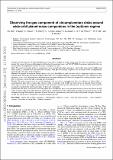Files in this item
Observing the gas component of circumplanetary disks around wide-orbit planet-mass companions in the (sub)mm regime
Item metadata
| dc.contributor.author | Rab, Ch | |
| dc.contributor.author | Kamp, I. | |
| dc.contributor.author | Ginski, C. | |
| dc.contributor.author | Oberg, N. | |
| dc.contributor.author | Muro-Arena, G. A. | |
| dc.contributor.author | Dominik, C. | |
| dc.contributor.author | Waters, L. B. F. M. | |
| dc.contributor.author | Thi, W. -F. | |
| dc.contributor.author | Woitke, P. | |
| dc.date.accessioned | 2019-03-22T12:30:07Z | |
| dc.date.available | 2019-03-22T12:30:07Z | |
| dc.date.issued | 2019-04-01 | |
| dc.identifier | 258237478 | |
| dc.identifier | a2502f7e-8f43-4b45-b66f-7fef877839e7 | |
| dc.identifier | 85063867697 | |
| dc.identifier | 000462847600001 | |
| dc.identifier.citation | Rab , C , Kamp , I , Ginski , C , Oberg , N , Muro-Arena , G A , Dominik , C , Waters , L B F M , Thi , W -F & Woitke , P 2019 , ' Observing the gas component of circumplanetary disks around wide-orbit planet-mass companions in the (sub)mm regime ' , Astronomy & Astrophysics , vol. 624 , A16 . https://doi.org/10.1051/0004-6361/201834899 | en |
| dc.identifier.issn | 0004-6361 | |
| dc.identifier.other | ArXiv: http://arxiv.org/abs/1902.04096v1 | |
| dc.identifier.uri | https://hdl.handle.net/10023/17346 | |
| dc.description | C.R., G.M.-A., and C.G. acknowledge funding from the Netherlands Organisation for Scientific Research (NWO) TOP-1 grant as part of the research programme “Herbig Ae/Be stars, Rosetta stones for understanding the formation of planetary systems”, project number 614.001.552. | en |
| dc.description.abstract | Context. Several detections of wide-orbit planet-mass/sub-stellar companions around young solar-like stars were reported in the last decade. The origin of those possible planets is still unclear but accretion tracers and VLT/SPHERE observations indicate that they are surrounded by circumplanetary material or even a circumplanetary disk. Aims. We want to investigate if the gas component of disks around wide-orbit companions is detectable with current (ALMA) and future (ngVLA) (sub)mm telescopes and what constraints such gas observations can provide on the nature of the circumplanetary material and on the mass of the companion. Methods. We applied the radiation thermo-chemical disk code PRODIMOto model the dust and gas component of passive circum-planetary disks and produced realistic synthetic observables. We considered different companion properties (mass, luminosity), disk parameters (mass, size, dust properties) and radiative environments (background fields) and compared the resulting synthetic observables to telescope sensitivities and to existing dust observations. Results. The main criterion for a successful detection is the size of the circumplanetary disk. At a distance of about 150 pc, acircumplanetary disk with an outer radius of about 10 au is detectable with ALMA in about 6 hours in optically thick CO lines.Other aspects such as the companion’s luminosity, disk inclination and background radiation fields are also relevant, and should be considered to optimize the observing strategy for detection experiments. Conclusions. For most of the known wide-orbit planet-mass companions, their maximum theoretical disk size of one third of the Hill radius would be sufficient to allow detection of CO lines. It is therefore feasible to detect their gas disks and constrain the mass of the companion through the kinematic signature. Even in the case of non-detections such observations will provide stringent constraints on disk size and gas mass, information crucial for formation theories. | |
| dc.format.extent | 17 | |
| dc.format.extent | 2840505 | |
| dc.language.iso | eng | |
| dc.relation.ispartof | Astronomy & Astrophysics | en |
| dc.subject | Planets and satellites: formation | en |
| dc.subject | Submillimeter: planetary systems | en |
| dc.subject | Stars: pre-main sequence | en |
| dc.subject | (Stars:) planetary systems | en |
| dc.subject | Accretion, accretion disks | en |
| dc.subject | Methods: numerical | en |
| dc.subject | QB Astronomy | en |
| dc.subject | QC Physics | en |
| dc.subject | 3rd-DAS | en |
| dc.subject.lcc | QB | en |
| dc.subject.lcc | QC | en |
| dc.title | Observing the gas component of circumplanetary disks around wide-orbit planet-mass companions in the (sub)mm regime | en |
| dc.type | Journal article | en |
| dc.contributor.institution | University of St Andrews. School of Physics and Astronomy | en |
| dc.contributor.institution | University of St Andrews. St Andrews Centre for Exoplanet Science | en |
| dc.identifier.doi | 10.1051/0004-6361/201834899 | |
| dc.description.status | Peer reviewed | en |
This item appears in the following Collection(s)
Items in the St Andrews Research Repository are protected by copyright, with all rights reserved, unless otherwise indicated.

